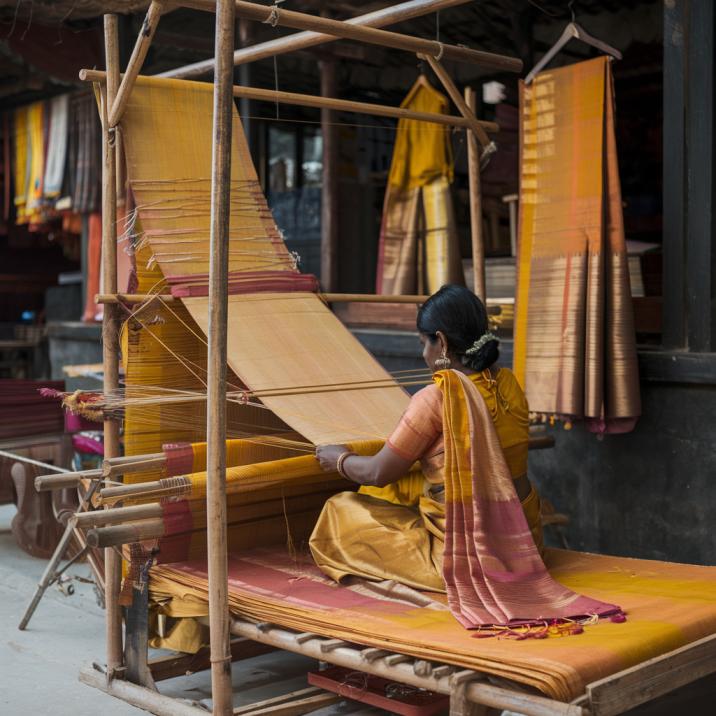Mastering Traditional Saree Craft of Traditional Saree Manufacturing
A saree is not just a garment, poetry draped in six yards of elegance, a tapestry of tradition whispering stories of heritage, artistry, and craftsmanship. Every warp and weft in a saree carries the soulful imprint of the weaver’s hands, a rhythmic dance of fingers that have mastered the delicate symphony of threads. But have you ever wondered what goes on behind the scenes before a saree graces the shoulders of a bride, a performer, or a modern woman celebrating her roots?
Welcome to the mesmerizing world of traditional saree weaving, a space where time slows down, where looms hum ancient lullabies, and where every saree is not just woven but birthed with love, patience, and centuries-old mastery.
From Threads to Masterpieces: The Birth of a Saree
The journey of a saree begins long before the first thread meets the loom. It starts with a vision of a design sketched in the mind of a weaver, inspired by folklore, nature, mythology, or even a fleeting moment of beauty. The process is meticulous, intricate, and deeply rooted in tradition.
From Threads to Masterpieces: The Birth of a Saree
The journey of a saree begins long before the first thread meets the loom. It starts with a vision of a design sketched in the mind of a weaver, inspired by folklore, nature, mythology, or even a fleeting moment of beauty. The process is meticulous, intricate, and deeply rooted in tradition.
The Threads of Gold and Silk: The Foundation
The soul of a saree lies in its yarn. Depending on the saree type, weavers carefully select silk, cotton, or blended fibers. They use pure mulberry silk with golden zari to craft the legendary Kanjeevaram sarees. At the same time, they weave the airy Chanderi sarees with silk-cotton blends that feel like whispers against the skin. Before weaving begins, the threads undergo degumming, dyeing, and sun-drying, transforming raw yarn into vibrant, textured strands ready to tell their story.
The Symphony of the Loom: Where Magic Happens
Step into a weaver’s workshop, and you will hear an enchanting melody; the rhythmic click-clack of wooden looms, the swish of shuttles darting between threads, and the murmur of artisans lost in creation. Saree weaving is a slow, deliberate process that requires impeccable precision and patience.
- Handloom weaving involves interlacing warp (vertical) and weft (horizontal) threads on a manually operated loom. This centuries-old technique results in heirloom pieces like Banarasi and Jamdani sarees, each of which takes weeks or months to complete.
- Jacquard weaving, used in intricately designed sarees, involves punch-card mechanisms that create complex motifs with mathematical precision.
- In Ikat weaving, artisans dye the threads before weaving them using a resist-dyeing method. This results in hypnotic, blurred patterns, a testament to the weaver’s sheer skill.
The Language of Motifs: Every Saree Tells a Story
A saree is not just a fabric but a canvas of symbolism and storytelling. Designers often draw the motifs adorning a saree from mythology, nature, and regional folklore:
- Peacocks, lotuses, and elephants in Kanjeevaram sarees symbolize prosperity and divine blessings.
- Paithani Sarees flaunt elaborate muniya (parrot) borders, narrating tales of Maharashtrian royalty.
- Jamdani Sarees feature floral vines that seem to float on fabric, a technique that once enchanted Mughal emperors.
Each thread is woven with intention and meaning, carrying cultural identity across generations.
Weaving Dreams: The Human Touch Behind Every Saree
Behind every saree is an artist, a weaver whose hands move with effortless grace, a craftsman whose eyes scan for the slightest flaw, a dyer who breathes color into the fabric, and an embroiderer who stitches dreams into every border. These artisans often come from families dedicated to saree-making, passing down their secrets like sacred heirlooms.
However, these skilled artisans struggle to keep their legacy alive in today’s fast-paced world of mass production and machine-made fabrics. With handwoven sarees taking weeks to create, they often compete with cheaper, power-loom alternatives. Yet, their passion remains unwavering, and their dedication ensures that every authentic handwoven saree remains a masterpiece of human artistry.
The Revival of Handwoven Sarees: A Movement, Not Just a Trend
The resurgence of handloom sarees in contemporary fashion isn’t just about nostalgia; it’s a movement. Eco-conscious consumers embrace sustainable fashion, and nothing exemplifies slow, ethical craftsmanship like a handwoven saree.
- Designers are reinventing classics, blending traditional motifs with modern silhouettes.
- Celebrities and influencers are making handloom sarees a red carpet staple.
- Handloom exhibitions and weaver cooperatives bring these artisans to the forefront, ensuring fair wages and global recognition.
Owning a handwoven saree isn’t just about fashion. It’s about honoring a craft, supporting a livelihood, and dressing in history.
Final Weave: More Than Just Fabric, A Legacy
One experiences a traditional saree, not just wear it. It’s the rustle of silk as you walk, the warmth of nostalgia in a grandmother’s cherished weave, the exquisite comfort of handwoven cotton on a summer afternoon. It’s an inheritance of stories, a labor of love, a connection between past and future.
So, the next time you drape a saree, remember, you’re not just wearing a fabric; you’re wearing history, art, and the untamed spirit of a weaver’s soul.


